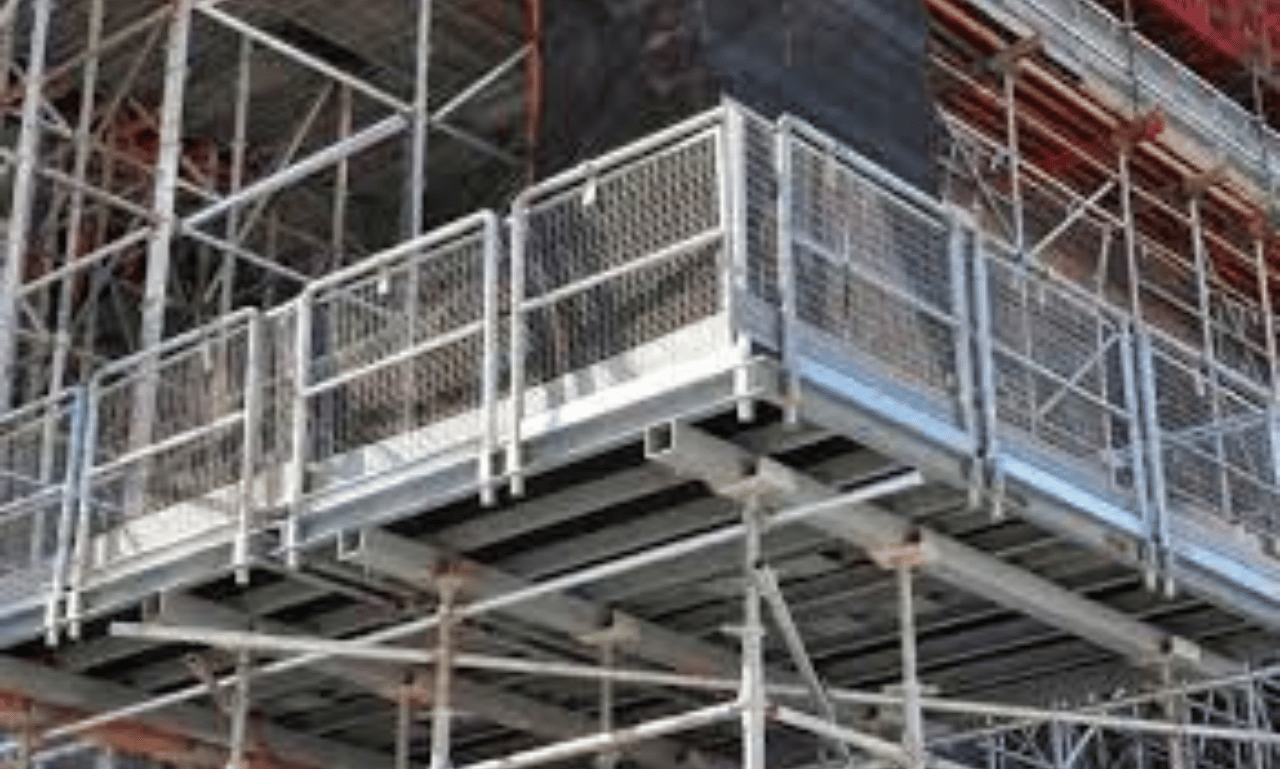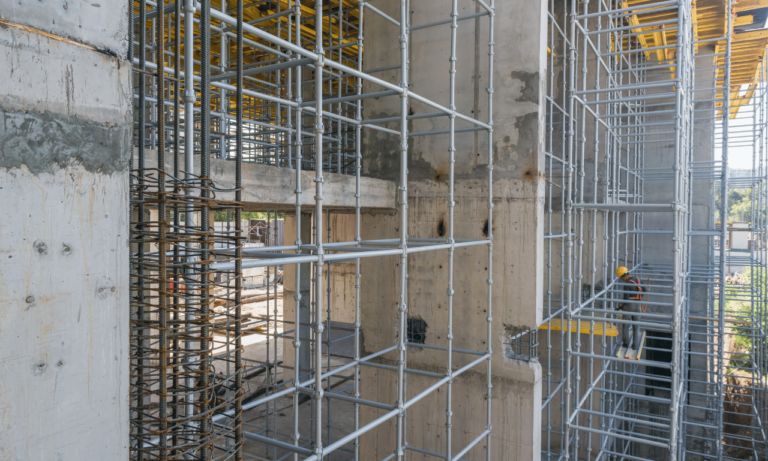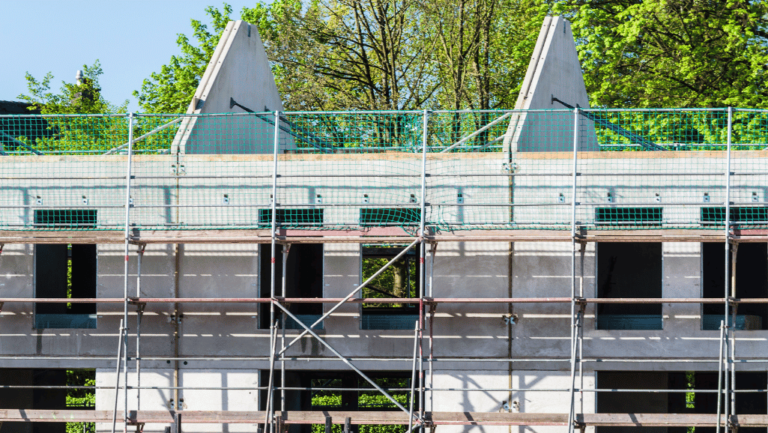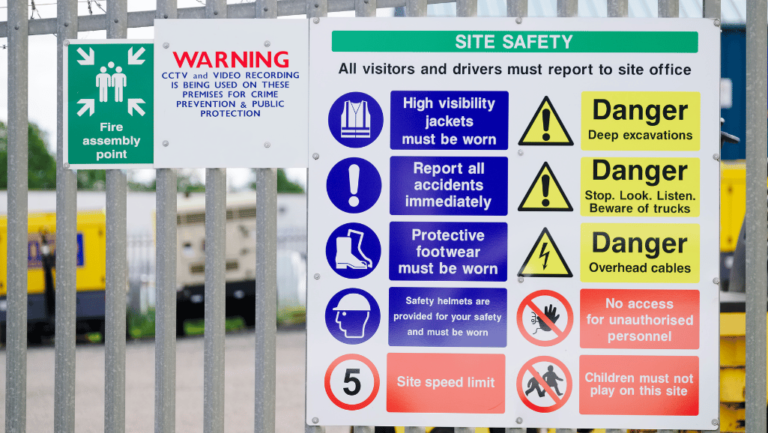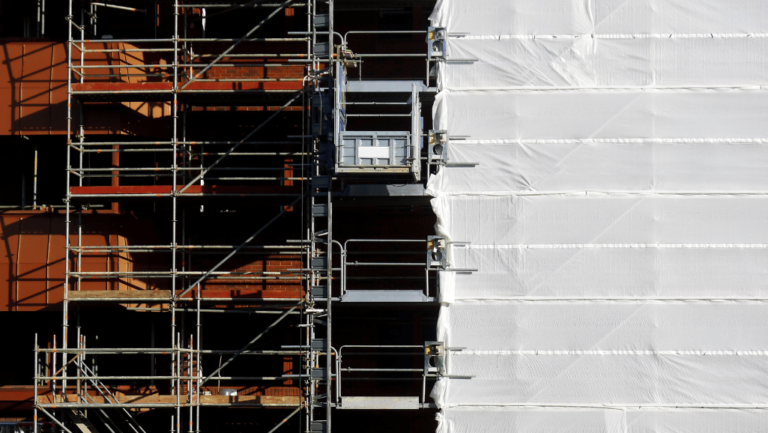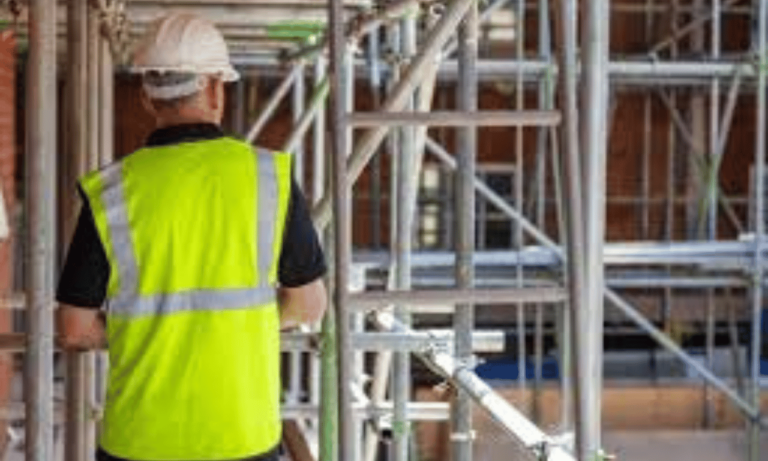Phone:
(+65)8319-0742
Construction site safety is of paramount importance, and ensuring the well-being of workers on elevated work platforms is crucial. One essential component of construction site safety is Scaffold Edge Protection systems. These systems provide fall protection and prevent accidents by implementing OSHA compliant guardrails and safety measures.
By understanding the regulations and guidelines surrounding Scaffold Edge Protection, companies can enhance safety on construction sites. Compliance with regulatory bodies such as OSHA is critical in implementing the right safety measures and preventing accidents.
Key Takeaways:
- Scaffold Edge Protection systems are essential for construction site safety.
- Compliance with regulatory bodies, such as OSHA, is crucial for implementing the right safety measures.
- Guardrails and safety measures are necessary to prevent falls and accidents on elevated work platforms.
- Choosing the right Scaffold Edge Protection system requires considering factors such as OSHA compliance, ease of installation, and durability.
- Various types of Scaffold Edge Protection systems, such as guardrail systems and safety nets, are available to enhance safety on construction sites.
Understanding Scaffold Edge Protection Regulations
When it comes to construction site safety, scaffold edge protection plays a crucial role in preventing accidents and ensuring the well-being of workers. In order to maintain safe working conditions, it is essential to comply with the regulations and guidelines set forth by regulatory bodies such as OSHA.
OSHA, the Occupational Safety and Health Administration, has established specific requirements for scaffold edge protection to minimize the risk of falls and other potential hazards. These regulations are designed to safeguard workers on elevated work platforms and promote a secure working environment.
By adhering to scaffold edge protection regulations, construction companies can demonstrate their commitment to worker safety and avoid costly penalties. It is important to stay up to date with the latest guidelines and ensure that all scaffold edge protection systems are in compliance with OSHA standards.
Key Scaffold Edge Protection Regulations
Some of the key regulations and requirements related to scaffold edge protection include:
- Guardrail Systems: OSHA mandates the use of guardrails as the primary means of fall protection on scaffolds. These guardrails should be installed along the edges of scaffolding platforms to prevent workers from accidentally falling off.
- Toeboards: Toeboards serve as protective barriers by preventing tools, equipment, or materials from falling from the scaffold platform. OSHA requires toeboards to be at least 3.5 inches in height and securely fastened to the scaffold structure.
- Scaffold Clearance: Regulatory guidelines specify the necessary clearance between scaffolding and adjacent structures or objects. This clearance ensures that workers have enough space to safely maneuver and prevents entanglement hazards.
It is important for construction site supervisors and workers to familiarize themselves with these regulations and ensure strict compliance to maintain a safe working environment. Regular inspections and maintenance of scaffold edge protection systems are also vital to identify any potential issues and address them promptly.
Stay Compliant and Prioritize Safety
Understanding and adhering to scaffold edge protection regulations is crucial for every construction site. By staying compliant and prioritizing safety, companies can protect their workers from accidents and create a culture of safety within the industry.
| Benefits of Understanding Scaffold Edge Protection Regulations | Key Takeaways |
|---|---|
| Demonstrate compliance with regulatory bodies | 1. Scaffold edge protection is essential for construction site safety. |
| Reduce the risk of accidents and penalties | 2. Compliance with scaffold edge protection regulations is crucial. |
| Create a safe working environment | 3. OSHA sets specific requirements for scaffold edge protection. |
The Importance of Scaffold Safety Measures
When it comes to construction site safety, implementing proper scaffold safety measures is of utmost importance. These measures aim to protect workers from potential falls and accidents, ensuring the overall well-being of everyone on the job site. By prioritizing Scaffold Edge Protection and fall protection systems, construction companies can create a secure working environment that complies with industry regulations and standards.
One of the key elements of scaffold safety is the use of effective guardrail systems. These act as a physical barrier, preventing workers from accidentally stepping off the edge of the scaffold platform. Guardrails should be installed at the perimeter of elevated work platforms, ensuring their stability and adherence to OSHA requirements.
In addition to guardrails, safety barriers play a crucial role in scaffold safety measures. Safety barriers, such as toe boards or netting, provide an extra layer of protection to prevent objects from falling off the scaffold platform. Implementing these safety measures reduces the risk of injuries caused by falling tools, materials, or debris.
By incorporating scaffold safety measures, construction site managers can significantly reduce the likelihood of accidents and injuries. These measures not only safeguard workers but also contribute to improved productivity and overall project efficiency. When workers feel safe and secure, they can focus on their tasks without unnecessary distractions or concerns for their well-being.
Providing proper training and education about scaffold safety measures is equally important. Workers should be familiar with the correct usage of guardrails, safety barriers, and other fall protection systems. Regular safety briefings and toolbox talks can reinforce the importance of adherence to safety protocols and promote a safety-conscious work culture.
Overall, scaffold safety measures should be an integral part of any construction site’s safety program. Through the implementation of guardrail systems, safety barriers, and comprehensive training, construction companies can ensure the protection of workers and maintain compliance with the necessary regulations. Prioritizing scaffold safety not only promotes construction site safety but also enhances productivity and reduces downtime caused by preventable accidents.
Key Benefits of Scaffold Safety Measures:
- Prevents falls and accidents on construction sites
- Enhances worker safety and well-being
- Reduces the risk of injuries and associated costs
- Increases productivity by providing a secure working environment
- Complies with industry regulations and standards
Example of Scaffold Safety Measures Implementation:
ABC Construction, a leading construction company, has implemented comprehensive scaffold safety measures across all of its projects. They prioritize the installation of OSHA compliant guardrail systems on all elevated work platforms. Additionally, ABC Construction requires workers to undergo regular scaffold safety training to ensure they understand the importance of using safety barriers and fall protection systems. By maintaining a strong focus on scaffold safety, ABC Construction has significantly reduced the number of accidents and injuries on their job sites, contributing to their outstanding safety record.
Choosing the Right Scaffold Edge Protection System
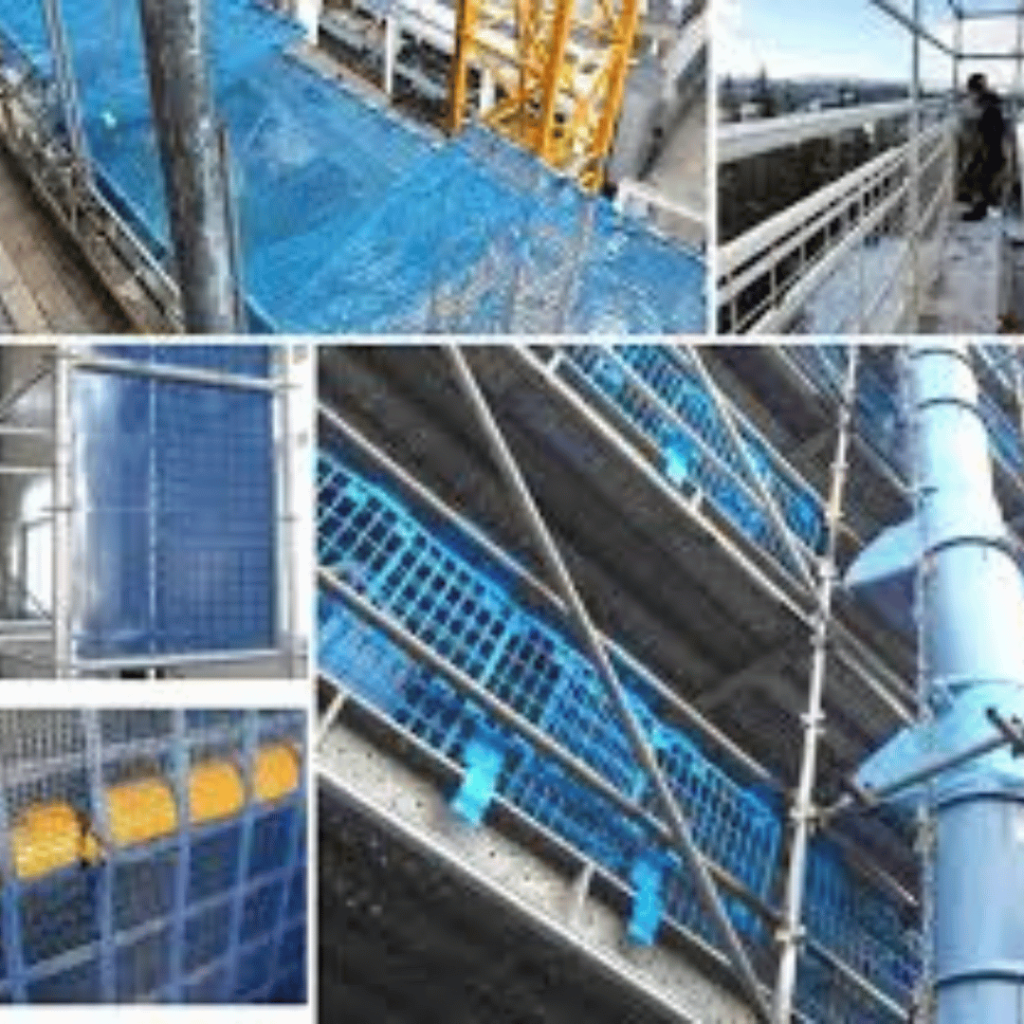
When it comes to ensuring construction site safety, selecting the appropriate Scaffold Edge Protection system is crucial. With numerous options available, it’s essential to consider key factors that will meet your specific needs. Here are some essential considerations to help you make an informed decision:
1. OSHA Compliance
One of the primary requirements for Scaffold Edge Protection systems is adherence to OSHA regulations. Ensure that the system you choose is OSHA compliant, meeting all the necessary safety standards and guidelines. OSHA compliant guardrails are essential for preventing falls and protecting workers on elevated work platforms.
2. Ease of Installation
Consider how easy it is to install the Scaffold Edge Protection system. Look for systems that offer a straightforward and efficient installation process. This can help save time and resources during construction or maintenance projects, ensuring that the edge protection is in place quickly and effectively.
3. Durability
Construction sites are dynamic environments that expose Scaffold Edge Protection systems to various challenges. Therefore, it’s crucial to choose a system that is durable and can withstand harsh conditions. Look for high-quality materials and robust construction to ensure the longevity and effectiveness of the edge protection solution.
By considering these essential factors, you can select a Scaffold Edge Protection system that not only prioritizes construction site safety but also offers practicality and longevity. Implementing the right edge protection solution will provide peace of mind, knowing that workers are protected from potential hazards and accidents.
Different Types of Scaffold Edge Protection Systems
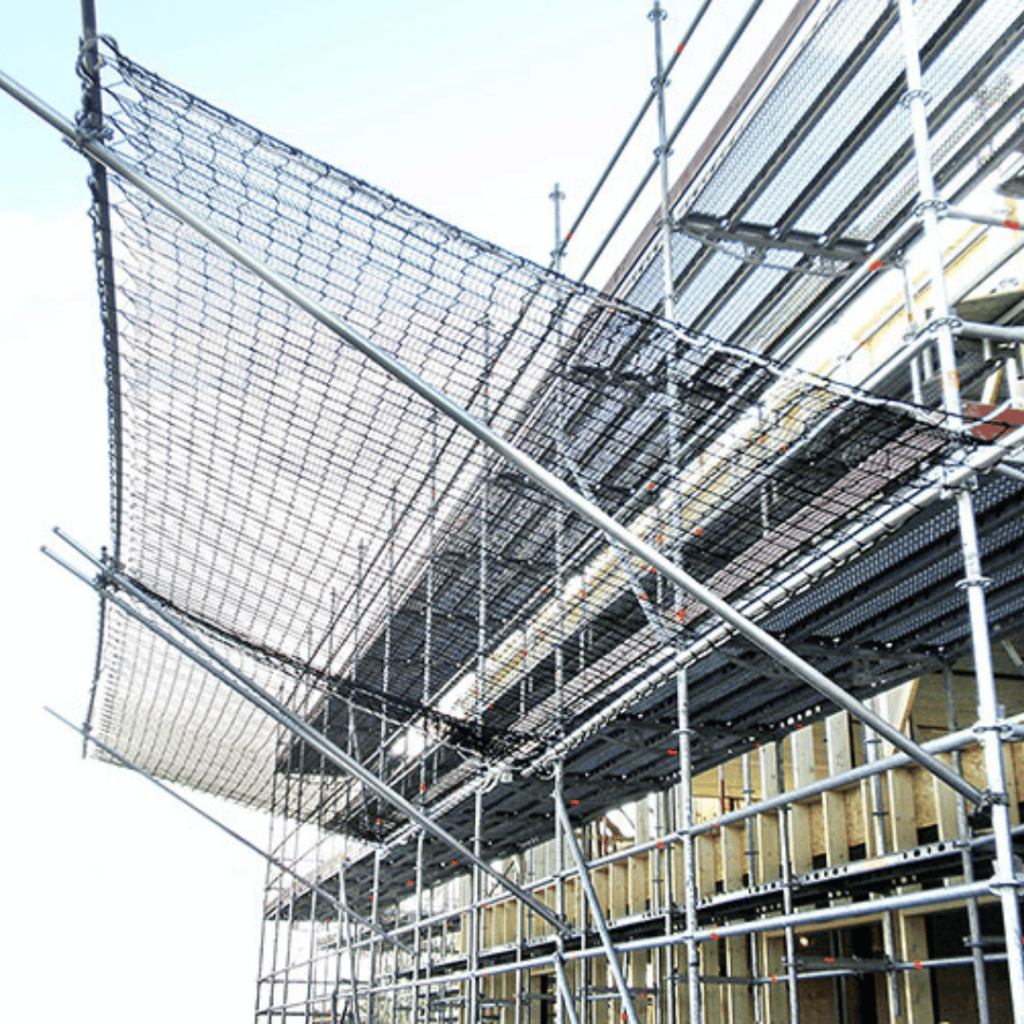
When it comes to Scaffold Edge Protection, there are various systems and solutions available on the market to enhance safety on elevated work platforms. From guardrail systems to safety nets, each option offers unique features and advantages. Let’s explore some of the different types of Scaffold Edge Protection systems:
1. Guardrail Systems
Guardrail systems are widely used in construction sites as a primary method of preventing falls and accidents. These systems consist of horizontal rails, vertical posts, and toe boards, forming a barrier around the scaffold edges. Guardrails offer stability, durability, and ease of installation, making them a popular edge protection solution.
2. Safety Nets
Safety nets provide an additional layer of fall protection when used alongside guardrail systems. These nets catch any debris or personnel that may fall, preventing them from hitting the ground. Safety nets are particularly useful when working at greater heights or in areas where objects could potentially fall, offering peace of mind to workers and minimizing the risk of injuries.
3. Toe Boards
Toe boards are another essential component of Scaffold Edge Protection systems. They are typically attached to the scaffold platform, acting as a vertical barrier and preventing tools, equipment, and debris from falling off the platform. Toe boards are versatile, cost-effective, and easy to install, making them a practical choice for edge protection in various construction scenarios.
These are just a few examples of Scaffold Edge Protection systems available in the market. It’s important to assess the specific requirements of your construction project and choose the most suitable solution to ensure the safety of workers and compliance with regulations.
| Scaffold Edge Protection System | Advantages |
|---|---|
| Guardrail Systems |
|
| Safety Nets |
|
| Toe Boards |
|
Benefits of OSHA Compliant Scaffold Edge Protection
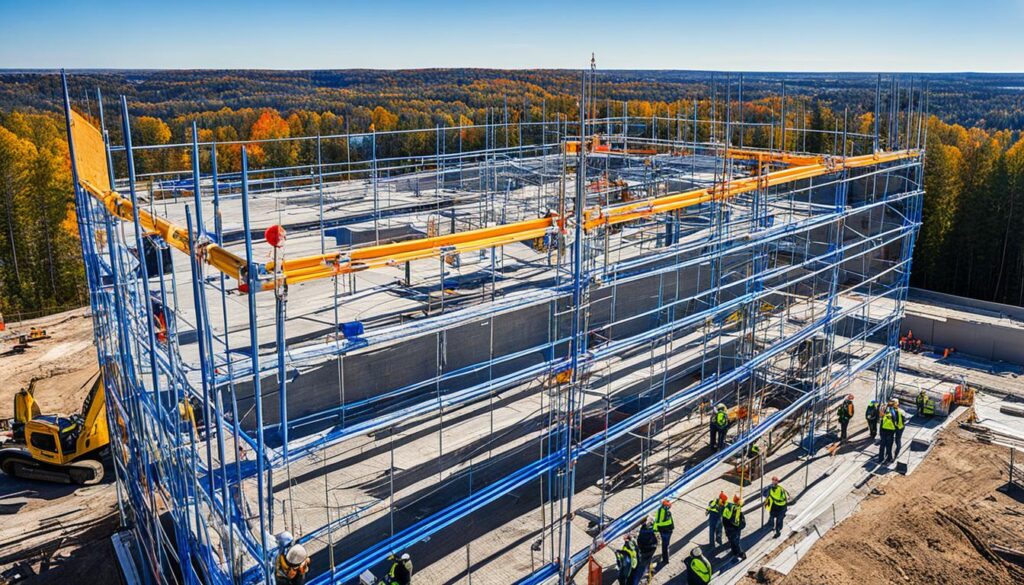
Implementing OSHA compliant Scaffold Edge Protection systems offers numerous benefits, greatly enhancing construction site safety and elevated work platform safety. These systems provide robust protection for workers and help organizations meet the necessary regulatory requirements.
Improved Worker Safety
OSHA compliant guardrails, an integral part of Scaffold Edge Protection systems, significantly reduce the risk of falls and accidents on construction sites. By creating secure boundaries and preventing unauthorized access to elevated work platforms, these systems ensure the safety of workers operating in high-risk areas.
The addition of Scaffold Edge Protection systems minimizes potential hazards and enables workers to focus on their tasks without unnecessary concerns about personal safety. This promotes a positive work environment and boosts productivity, which contributes to the overall success of construction projects.
Compliance with OSHA Regulations
Meeting OSHA regulations is crucial for construction site safety and can help organizations avoid penalties and legal issues. OSHA compliant Scaffold Edge Protection systems are designed to adhere to these regulations, ensuring that companies remain in full compliance.
By implementing these systems, companies demonstrate their commitment to maintaining a safe working environment and prioritize the well-being of their employees. This commitment also helps build trust and confidence with clients and stakeholders who value worker safety as a top priority.
Reduction in Accidents and Penalties
Scaffold Edge Protection systems play a vital role in reducing accidents and injuries on construction sites. By providing effective fall prevention measures, such as guardrails, these systems create a safer working environment for everyone involved.
The implementation of OSHA compliant guardrails significantly lowers the risk of falls from elevated work platforms, preventing potential injuries and even fatalities. This not only protects workers but also saves companies from costly legal battles, medical expenses, and reputational damage that can arise from accidents on their premises.
Cost-Effective Solution
Investing in OSHA compliant Scaffold Edge Protection systems is a cost-effective solution for construction companies in the long run. By reducing the occurrence of accidents and injuries, these systems minimize the financial burden associated with medical costs, insurance claims, and legal liabilities.
Additionally, by prioritizing worker safety and implementing these systems, companies can avoid project delays resulting from accidents or non-compliance, leading to increased productivity and profitability.
| Benefits | Description |
|---|---|
| Improved Worker Safety | OSHA compliant Scaffold Edge Protection systems provide robust protection, reducing the risk of falls and accidents. |
| Compliance with OSHA Regulations | Implementing these systems ensures adherence to OSHA regulations and demonstrates a commitment to safety. |
| Reduction in Accidents and Penalties | Scaffold Edge Protection systems help reduce accidents, injuries, and potential penalties. |
| Cost-Effective Solution | Investing in these systems minimizes financial burdens associated with accidents and non-compliance. |
By prioritizing the use of OSHA compliant guardrails and Scaffold Edge Protection systems, construction companies can create safer work environments, protect their workers, and achieve compliance with industry regulations. These systems not only mitigate the risk of accidents but also contribute to the overall success and reputation of construction projects.
Tips for Installing Scaffold Edge Protection
Proper installation of Scaffold Edge Protection systems is crucial for maintaining construction site safety. By following these tips and guidelines, you can ensure that your edge protection solutions are installed correctly and effectively:
1. Understand the Manufacturer's Instructions
Before starting the installation process, thoroughly review the manufacturer’s instructions and guidelines. This will provide you with essential information on proper assembly, anchoring, and any specific requirements for the scaffold edge protection system you are using. Adhering to these instructions will help guarantee the system’s effectiveness and compliance with safety regulations.
2. Conduct a Site Inspection
Prior to installation, it is essential to conduct a thorough inspection of the construction site. Identify potential hazards, such as uneven terrain, nearby utility lines, or other obstacles that may hinder installation or compromise the effectiveness of the scaffold edge protection. Address these issues before proceeding with the installation process.
3. Use Proper Anchoring Techniques
Proper anchoring is crucial for the stability and reliability of scaffold edge protection systems. Ensure that all anchors are securely fastened and capable of withstanding the expected loads. Follow the manufacturer’s guidelines for anchoring techniques, paying particular attention to weight capacity and the type of structure the system will be attached to.
4. Perform Regular Inspections
Once the scaffold edge protection system is installed, regular inspections are necessary to ensure ongoing site safety. Inspect the system for any signs of damage, wear and tear, or loose components. Promptly address any issues discovered during these inspections to maintain the integrity and effectiveness of the edge protection solution.
5. Provide Proper Training
Ensure that all workers involved in erecting, dismantling, and working on scaffold edge protection systems receive proper training. They should understand the correct procedures for installation, usage, and inspection, as well as the applicable safety regulations. Well-trained personnel are essential for maintaining a safe construction site environment.
By following these tips for installing scaffold edge protection systems, you can enhance construction site safety and reduce the risk of accidents. Remember, safety should always be a priority, and proper installation is a fundamental step towards creating a secure working environment.
Conclusion
Scaffold Edge Protection is an indispensable component of construction site safety. By implementing OSHA compliant guardrails and edge protection solutions, companies can prioritize the well-being of their workers while ensuring compliance with industry regulations. Safety barriers and other safety measures play a crucial role in reducing the risk of accidents and creating a secure working environment.
Investing in Scaffold Edge Protection not only protects workers from falls but also demonstrates a commitment to their safety. By choosing the right edge protection solutions, companies can mitigate potential hazards and minimize the likelihood of workplace incidents. Providing a robust safety framework not only safeguards the workforce but also reduces the financial and legal risks associated with non-compliance.
Whether it’s using guardrail systems, safety nets, or other innovative solutions, Scaffold Edge Protection offers a versatile range of options to enhance safety on elevated work platforms. By prioritizing the implementation of these systems, construction companies can create a culture of safety, letting workers focus on their tasks without the fear of accidents. Safety barriers are not only a legal requirement but also an investment in the well-being of workers and the overall success of construction projects.
FAQ
Are Scaffold Edge Protection systems necessary on construction sites?
Yes, Scaffold Edge Protection systems are essential for construction site safety. They provide fall protection systems and OSHA compliant guardrails to prevent accidents and ensure the safety of workers on elevated work platforms.
What are the regulations regarding Scaffold Edge Protection?
Scaffold Edge Protection is subject to specific regulations and guidelines set by regulatory bodies like OSHA. These regulations define the requirements for guardrails and other safety measures to enhance construction site safety and prevent falls.
Why is it important to implement scaffold safety measures?
Implementing scaffold safety measures is crucial to protect workers from accidents and falls on construction sites. These measures include guardrail systems, safety barriers, and fall protection systems, which significantly reduce the risk of injuries and ensure a secure working environment.
How do I choose the right Scaffold Edge Protection system?
When selecting a Scaffold Edge Protection system, it is essential to consider factors such as OSHA compliance, ease of installation, and durability. Choosing a system that meets regulatory requirements and suits your specific needs is vital for maintaining construction site safety.
What are the different types of Scaffold Edge Protection systems available?
There are various types of Scaffold Edge Protection systems available, including guardrail systems, safety nets, and other innovative solutions. These systems provide different levels of protection and allow for enhanced safety on elevated work platforms.
What are the benefits of using OSHA compliant Scaffold Edge Protection systems?
Using OSHA compliant Scaffold Edge Protection systems offers multiple benefits. It ensures the safety of workers on elevated work platforms, helps companies meet regulatory requirements, reduces the risk of accidents and penalties, and creates a safer working environment overall.
What are some tips for installing Scaffold Edge Protection systems?
Proper installation of Scaffold Edge Protection systems is essential for their effectiveness. Some tips include following installation techniques, conducting regular inspections, and performing necessary maintenance. These steps will ensure ongoing safety on construction sites.

